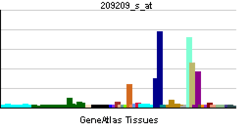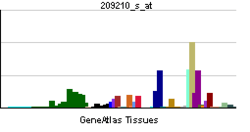FERMT2
| View/Edit Human | View/Edit Mouse |
Fermitin family homolog 2 (FERMT2) also known as pleckstrin homology domain-containing family C member 1 (PLEKHC1) is a protein that in humans is encoded by the FERMT2 gene.[4][5][6]
Function
FERMT2 is a component of extracellular matrix structures in mammalian cells and is required for proper control of cell shape change.[7]
Interactions
FERMT2 has been shown to interact with FBLIM1.[7]
References
- ↑ "Diseases that are genetically associated with FERMT2 view/edit references on wikidata".
- ↑ "Human PubMed Reference:".
- ↑ "Mouse PubMed Reference:".
- ↑ Wick M, Bürger C, Brüsselbach S, Lucibello FC, Müller R (January 1994). "Identification of serum-inducible genes: different patterns of gene regulation during G0-->S and G1-->S progression". J. Cell. Sci. 107 (1): 227–39. PMID 8175911.
- ↑ Weinstein EJ, Bourner M, Head R, Zakeri H, Bauer C, Mazzarella R (April 2003). "URP1: a member of a novel family of PH and FERM domain-containing membrane-associated proteins is significantly over-expressed in lung and colon carcinomas". Biochim. Biophys. Acta. 1637 (3): 207–16. doi:10.1016/S0925-4439(03)00035-8. PMID 12697302.
- ↑ "Entrez Gene: FERMT2".
- 1 2 Tu Y, Wu S, Shi X, Chen K, Wu C (April 2003). "Migfilin and Mig-2 link focal adhesions to filamin and the actin cytoskeleton and function in cell shape modulation". Cell. 113 (1): 37–47. doi:10.1016/S0092-8674(03)00163-6. PMID 12679033.
External links
- FERMT2 Info with links in the Cell Migration Gateway
Further reading
- Tu Y, Wu S, Shi X, Chen K, Wu C (2003). "Migfilin and Mig-2 link focal adhesions to filamin and the actin cytoskeleton and function in cell shape modulation". Cell. 113 (1): 37–47. doi:10.1016/S0092-8674(03)00163-6. PMID 12679033.
- Siegel DH, Ashton GH, Penagos HG, Lee JV, Feiler HS, Wilhelmsen KC, South AP, Smith FJ, Prescott AR, Wessagowit V, Oyama N, Akiyama M, Al Aboud D, Al Aboud K, Al Githami A, Al Hawsawi K, Al Ismaily A, Al-Suwaid R, Atherton DJ, Caputo R, Fine JD, Frieden IJ, Fuchs E, Haber RM, Harada T, Kitajima Y, Mallory SB, Ogawa H, Sahin S, Shimizu H, Suga Y, Tadini G, Tsuchiya K, Wiebe CB, Wojnarowska F, Zaghloul AB, Hamada T, Mallipeddi R, Eady RA, McLean WH, McGrath JA, Epstein EH (2003). "Loss of Kindlin-1, a Human Homolog of the Caenorhabditis elegans Actin–Extracellular-Matrix Linker Protein UNC-112, Causes Kindler Syndrome". Am. J. Hum. Genet. 73 (1): 174–87. doi:10.1086/376609. PMC 1180579
 . PMID 12789646.
. PMID 12789646. - Kato K, Shiozawa T, Mitsushita J, Toda A, Horiuchi A, Nikaido T, Fujii S, Konishi I (2004). "Expression of the mitogen-inducible gene-2 (mig-2) is elevated in human uterine leiomyomas but not in leiomyosarcomas". Hum. Pathol. 35 (1): 55–60. doi:10.1016/j.humpath.2003.08.019. PMID 14745725.
- Rual JF, Venkatesan K, Hao T, Hirozane-Kishikawa T, Dricot A, Li N, Berriz GF, Gibbons FD, Dreze M, Ayivi-Guedehoussou N, Klitgord N, Simon C, Boxem M, Milstein S, Rosenberg J, Goldberg DS, Zhang LV, Wong SL, Franklin G, Li S, Albala JS, Lim J, Fraughton C, Llamosas E, Cevik S, Bex C, Lamesch P, Sikorski RS, Vandenhaute J, Zoghbi HY, Smolyar A, Bosak S, Sequerra R, Doucette-Stamm L, Cusick ME, Hill DE, Roth FP, Vidal M (2005). "Towards a proteome-scale map of the human protein-protein interaction network". Nature. 437 (7062): 1173–8. doi:10.1038/nature04209. PMID 16189514.
- Olsen JV, Blagoev B, Gnad F, Macek B, Kumar C, Mortensen P, Mann M (2006). "Global, in vivo, and site-specific phosphorylation dynamics in signaling networks". Cell. 127 (3): 635–48. doi:10.1016/j.cell.2006.09.026. PMID 17081983.
This article is issued from Wikipedia - version of the 5/20/2016. The text is available under the Creative Commons Attribution/Share Alike but additional terms may apply for the media files.


